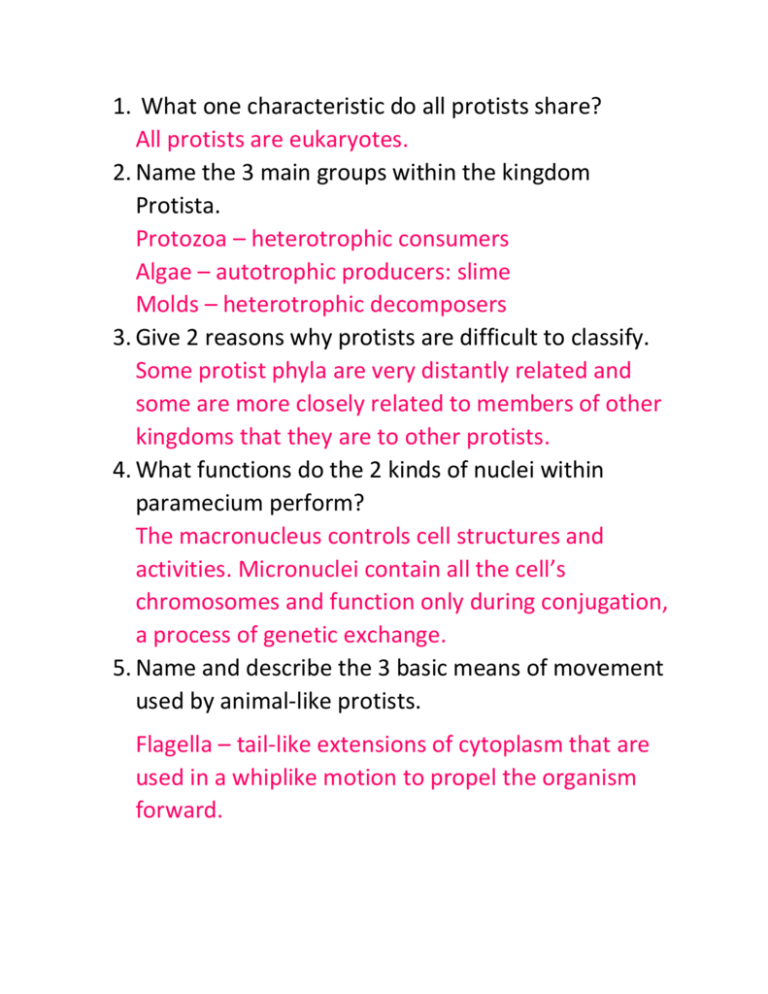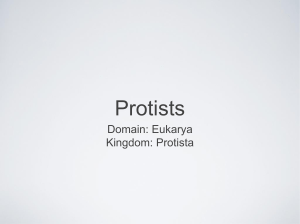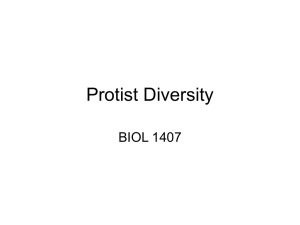Protists and Fungi Worksheet: Classification & Function
advertisement

1. What one characteristic do all protists share? All protists are eukaryotes. 2. Name the 3 main groups within the kingdom Protista. Protozoa – heterotrophic consumers Algae – autotrophic producers: slime Molds – heterotrophic decomposers 3. Give 2 reasons why protists are difficult to classify. Some protist phyla are very distantly related and some are more closely related to members of other kingdoms that they are to other protists. 4. What functions do the 2 kinds of nuclei within paramecium perform? The macronucleus controls cell structures and activities. Micronuclei contain all the cell’s chromosomes and function only during conjugation, a process of genetic exchange. 5. Name and describe the 3 basic means of movement used by animal-like protists. Flagella – tail-like extensions of cytoplasm that are used in a whiplike motion to propel the organism forward. Pseudopods- the plasma membrane and cytoplasm extend to form a bulge that anchors to the surface and pulls the rest of the organism along. Cilia- short hairlike structures on the surface of the organism that wave. 6. Describe how the parasite Plasmodium causes disease in humans. The bite of a mosquito carrying Plasmodium transmits sporozoites into a human’s bloodstream. The sporozoites enter the liver, where they develop and then move to red blood cells. They reproduce asexually until the red blood cells burst open, releasing Pasmodium cells that can then be ingested by mosquitoes that bite the infected host. 7. COMPARE AND CONTRAST – In what ways are cilia and flagella similar? How are they different? Cilia and flagella are both used for movement in protists. Both are formed from the cell membrane and are permanent structures. Cilia are shorter and more hairlike and can be in rows or clusters that cover parts of a cell or the entire cell. Flagella are longer, and there are usually only one or two per cell. 8. What are the similarities and differences between green, brown, and red algae? Green, red and brown algae are photosynthetic ad aquatic. They are usually all multicellular. They all have chlorophyll a. green algae also have chlorophyll b, and brown algae also have chlorophyllc. Red algae can grow deeper than green and brown algae due to the blue light- absorption properties of the red pigments. 9. Give an example of each of the following: a colonial, and a multicellular plantlike protist. 10. In what ways are slime molds and water molds similar to fungi? These funguslike protists also are decomposers that recycle nutrients back into the soil. 11. Describe how fungi use hyphae to obtain their food. The hyphae extend into the food source and release enzymes that break the food down. Nutrients are then absorbed across the cell walls. 12. How do fungi contribute to the balance of an ecosystem? By decomposing organic matter and recycling nutrients. 13. What are three ways that fungi benefit humans? a. lichens produce oxygen b. they grow in unfavorable environments, which then allows other organisms to grow. c. they are indicators of air quality. d. they are important decomposers that return nutrients to the soil. e. they can be used to produce antibiotic compounds f. their components are used as dyes.











